A life in medicine and medical research
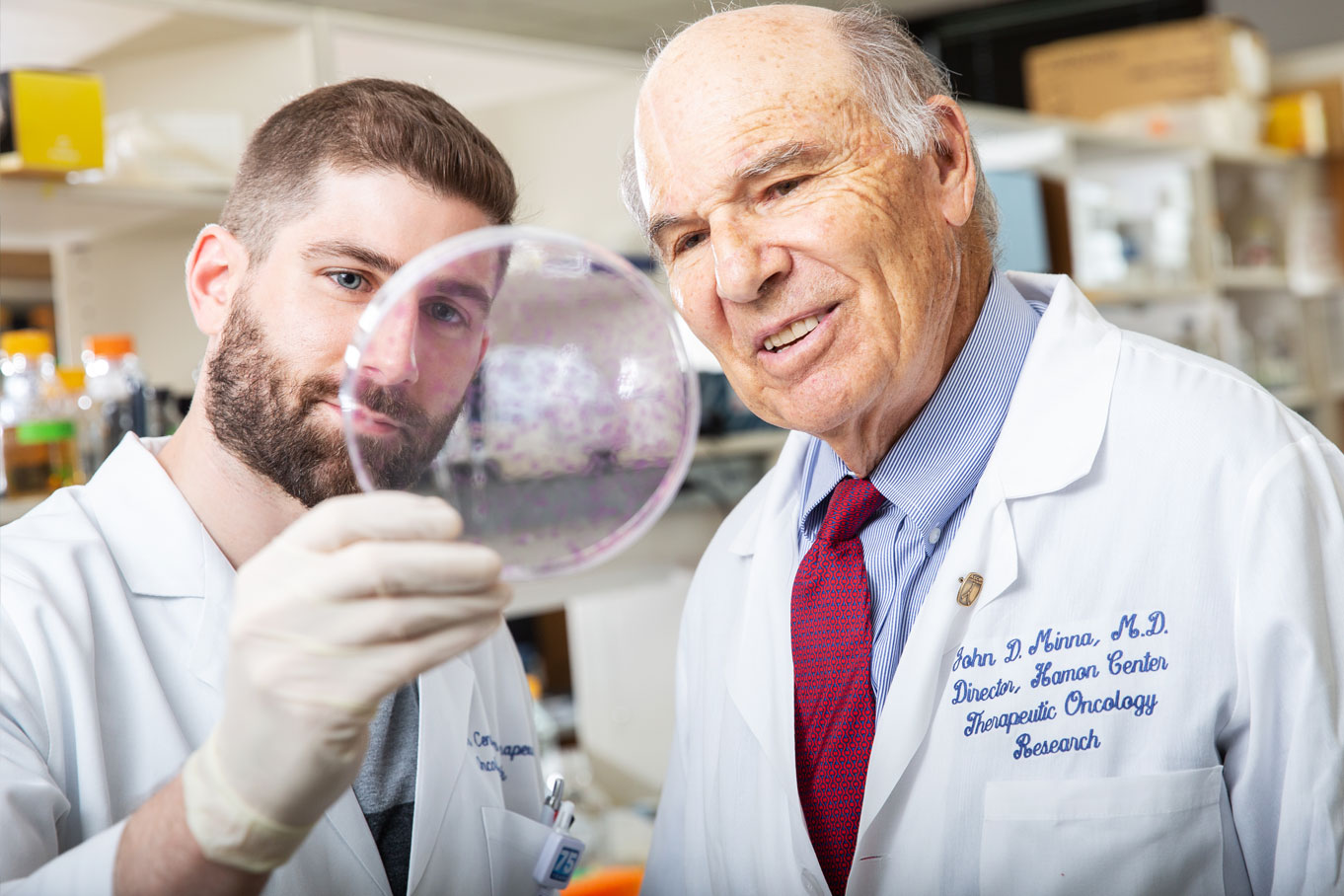
Dr. John D. Minna, Director of the W.A. “Tex” and Deborah Moncrief Jr. Center for Cancer Genetics and Co-Director of the Experimental Therapeutics Program at the Harold C. Simmons Comprehensive Cancer Center, has spent decades elucidating the genetic changes associated with lung cancer development. His work seeks to identify biomarkers to detect lung cancer earlier and to develop new therapies. Since joining UTSW in 1991, Dr. Minna has been a Professor of Internal Medicine and Pharmacology and he became the Director of the Nancy B. and Jake L. Hamon Center for Therapeutic Oncology Research in 1995. He also leads a joint National Cancer Institute Specialized Program of Research Excellence (SPORE) in Lung Cancer grant between UTSW and MD Anderson Cancer Center. In this conversation, Dr. Minna shared his thoughts about progress in lung cancer research and his personal career journey, including work with his late research colleague Dr. Adi Gazdar, with whom he created some of the world’s first lung cancer cell lines used for research.
Can you tell us about your early life and how you became interested in medicine?
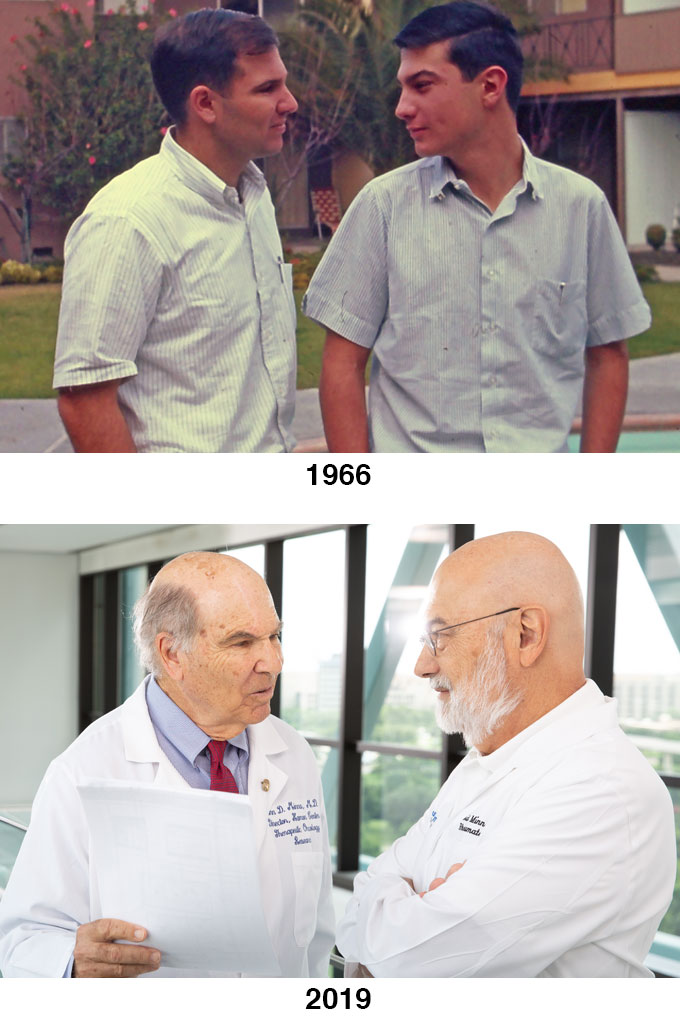
I was born in San Francisco at Letterman General Hospital in the Presidio, which is now a fancy movie studio, during World War II while my dad was in the Army. I grew up in San Diego. My dad had emigrated from Italy, attended the University of Colorado Medical School, and had the largest family practice in San Diego. My mom was a nurse, and the two of them ran “the office.” My dad made house calls – remember those? – and I must have gone with him hundreds of times at night, carrying his bag. Our family life revolved around this medical practice. My father delivered babies – many thousands – and frequently performed or assisted at surgeries. I just knew I was going to go into medicine from the time I was a kid. I feel sure my younger brother, Dr. David Minna, Professor of Internal Medicine at UT Southwestern, had a similar experience as we both went into medicine. It is great having David here on the faculty.
How did your interest in research come about?
All of my dad’s medical friends were surgeons – and they all kept telling me to come back to San Diego and take over a surgical practice. However, as an undergraduate and during medical school at Stanford, I fell in love with research. My dad, who was admitted to a pediatric residency at Harvard but unable to go because of the Great Depression, urged me to follow my dreams and do medical research. While still an undergraduate, on a whim, I took a graduate course in genetics and got hooked. To kill time during the summer before entering medical school, I started doing computer programming at San Diego State – we are talking Fortran on punch cards here. When I started medical school, they had introductory dinners for students and a few faculty. I found myself describing that summer job to this guy who was wolfing down spaghetti. It turned out to be Dr. Joshua Lederberg – who won the Nobel Prize in Physiology or Medicine at the age of 33 for discovering bacterial conjugation. He paused and said, “You are coming to work Monday in the Department of Genetics doing programming.” It turned out Dr. Lederberg not only founded the Department of Genetics but established the field of computational biology and advanced those technologies at Stanford. He taught me about trying to attack deep and important questions.
What experiences set you on your course?
In the Department of Genetics, I was tremendously fortunate to be taken into the laboratory of Professors Len (Leonard) and Lee (Leonore) Herzenberg. They were using mouse genetics to study immunoglobulin genes and the immune response, so my first work involved such genetics. They were terrific in so many different ways, particularly teaching critical thinking about experiments: how to do and analyze them. While they were intellectually very tough, they created a fun, nurturing interactive lab environment. They went on to develop the fluorescence activated cell sorter (FACS) machine, which revolutionized biology. Also, while at medical school I was incredibly fortunate to have two of the early pioneers in cancer clinical research take me under their wings. I learned about the meticulous conduct of clinical trials, the integration of laboratory and clinical studies, and the importance of mentoring from Dr. Henry Kaplan, who founded Stanford Radiation Oncology, developed the linear accelerator, and led some of the first clinical trials on Hodgkin’s disease. He worked closely on lymphoma clinical trials with Dr. Saul Rosenberg, one of the founders of medical oncology. Exposure to these two wonderful mentors made me go into cancer care and research.
Can you describe your journey from Research Assistant at the National Institutes of Health (NIH) to Chief of the Section of Somatic Cell Genetics at the National Heart, Lung, and Blood Institute (NHLBI)?
After Stanford, coming to the NIH was tremendously formative for my scientific career. At the center of this was my boss, Dr. Marshall Nirenberg, who had recently won the Nobel Prize in Physiology or Medicine for describing the genetic code and how it functions in protein synthesis. At this point, he had decided to study the nervous system and became one of the founding fathers of neurobiology. He taught me how to crystalize a project, to be fearless, to collaborate with people with other expertise, and to foster a true love of science. He embraced the idea of applying genetics to study the nervous system. He was also tremendously generous with me and gave me the opportunity to be an independent investigator. I owe him a lot.
And can you describe your work at the NCI-VA and NCI-Navy Medical Oncology Branches?
The final part of my training came when I asked Dr. Vincent DeVita (who became Director of the National Cancer Institute) if I could do an oncology fellowship at the NCI. He told me no, but said instead I could direct one of the clinical branches of the NCI. Initially, this was the NCI-Veterans Administration Medical Oncology Branch, which later moved to the National Naval Medical Center to become the NCI-Navy Medical Oncology Branch. So, I got a “battlefield” promotion. These positions led to my study of lung cancer.
Nearly every patient we saw went on to participate in a clinical trial and had their tumors studied in the lab. The faculty I was fortunate enough to recruit became some of the leading clinical or laboratory investigators of our time, including Drs. Adi Gazdar, Paul Bunn, Dan Ihde, Desmond Carney, Martin Cohen, Mary Matthews, Jim Mulshine, Ilona Linnoila, Barry Kramer, Jim Battey, Ilan Kirsch, and Bruce Johnson. One of the key people who mentored me was Dr. Eli Glatstein, the NCI’s Chief of Radiation Oncology, who helped found the Department of Radiation Oncology at UT Southwestern. Eli was like an older brother to me and was essential to my success at the NCI and later here at UT Southwestern.
What made you decide to go into academic medicine and what drew you to UT Southwestern?
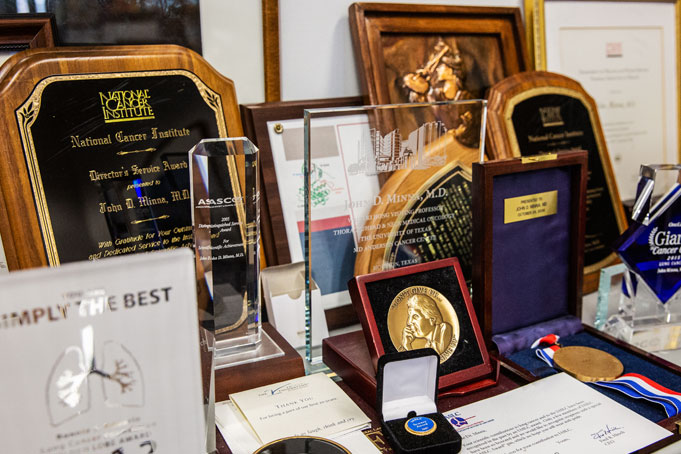
My experiences at Stanford, the NIH, and the NCI set the course for academic medicine. What drew me to UT Southwestern was the opportunity to be part of creating the cancer center of the future, my personal relationships with Nobel Laureates Drs. Al Gilman, Joe Goldstein, and Mike Brown, the city of Dallas, and my wife, Lynn. Dr. Kern Wildenthal, President of UT Southwestern at the time, sold me on his vision for the University to play a leadership role in cancer. Just as important was the tremendous philanthropic support my work received from Harold Simmons, Nancy Hamon, Tex and Deborah Moncrief, John Johnson, Barbara Lemon (for Max Thomas), and Charlie and Sarah Seay. As part of this, Margaret McDermott took Lynn and me in and showed us how welcome we would be in Dallas. Joe Goldstein and Mike Brown had been residents at Massachusetts General Hospital a year ahead of me, and while I knew of their great scientific accomplishments, I also remembered and saw firsthand what tremendous clinicians they were. If they thought UT Southwestern was the place to be, I figured I should look at it closely. Al Gilman and I had been postdoctoral fellows together in Marshall Nirenberg’s lab and we published some of our first independent papers together. He convinced me that scientifically UT Southwestern would be the best place for me to grow and achieve my dreams.
How has the University changed since your arrival?
The tremendous growth of buildings for both clinical care and laboratory research is amazing. However, there has been an even more important change in how people interact and perform science and medicine. When I got here, there was definitely the mentality that everyone had “their R01,” “their lab,” or their particular clinical specialty. Just about everything was “department-based” and the clinical work was 90 percent at Parkland Memorial Hospital, with little delivery of care to private patients. All of this has dramatically changed – UT Southwestern science has become multidisciplinary with department boundaries blurred as has clinical care – particularly in cancer care. Now a team of physicians and their extenders come together to work out complex diagnostic, treatment, and follow-up plans for patients. In addition, clinicians and laboratory-based scientists are working together to solve a host of problems and perform clinical translational trials. The University culture is now very different – in a good way – from what it was when I arrived.
Tell us about your longtime collaboration with your late research partner, Dr. Adi Gazdar. How did that partnership come about and how did it help lead to discoveries at UT Southwestern?
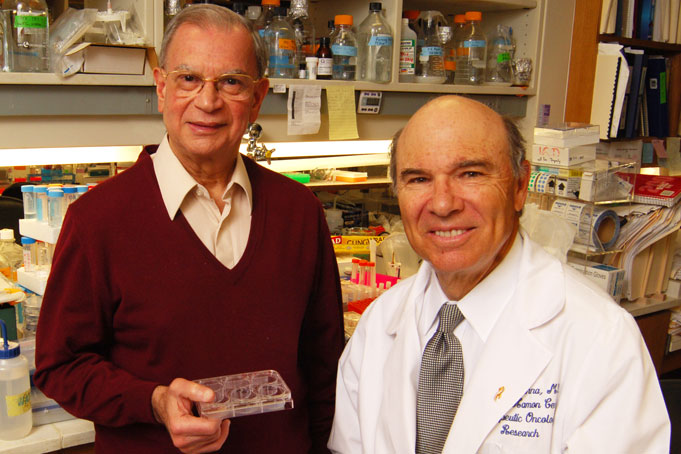
Adi and I met at the NIH. Adi was working on cancer viruses. We started by collaborating to study the somatic cell genetics of retroviruses to identify genes responsible for viral receptors and replication in human and mouse cells. When I was asked by Vincent DeVita to lead the NCI-Veterans Administration Medical Oncology Branch, my first recruitment effort was to convince Adi to come along with me to run the laboratory program since he was a trained pathologist. Since many cancer patients at the Washington, D.C., VA Medical Center had lung cancer, I knew we needed to make that our focus. Adi came with me to continue this work at the National Navy Medical Center. Adi was a great cell biologist, so we combined my genetics with his cell biology for our lung cancer studies throughout our long partnership. Because we were taking care of the patients we were studying in NCI clinical trials, we always tried to relate the laboratory studies to the clinical findings. Of course, with the development of new technologies, our work at UT Southwestern became much more sophisticated.
You and Dr. Gazdar created some of the world’s first lung cancer cell lines for research that are now used worldwide. Tell us how that came about and any challenges you encountered to accomplishing that feat.
We now have over 500 tumor cell lines or xenografts, and probably every one of them can or will help in some way in figuring out how to better treat lung cancer. When we started at the NCI, our major clinical focus was on lung cancer – but no one at that time had a panel of lung cancer lines to study in the laboratory, so we knew we had to create this panel. At the same time, there were advances in tissue culture techniques and identification of growth factors that really helped in the effort. Actually, the biggest obstacles turned out to be cultural and not scientific. People would ask us, “Why are you studying lung cancer? Everyone is going to die anyway.” Or, “Why do you want to use genetics to study lung cancer? It is not an inherited disease.” Of course, in retrospect these considerations all seem stupid, but they were very real at the time, and, thankfully, Adi Gazdar and I believed in each other and kept working on the problem.
Can you describe the UT Specialized Program of Research Excellence (SPORE)?
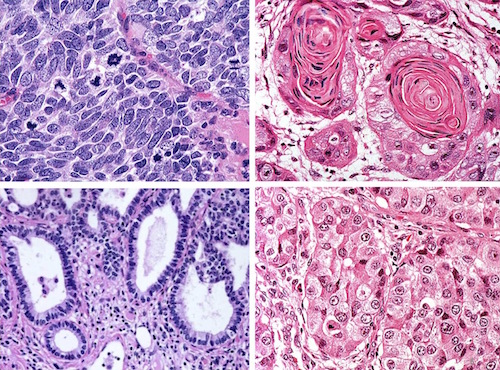
This has been a great collaboration over 20 years between scientists at UT Southwestern and those at MD Anderson Cancer Center working on lung cancer. The focus has been on trying to understand lung cancer at a fundamental molecular level and to develop new treatment approaches based on this knowledge. This includes developing precision medicine for lung cancer. We have published more than 1,000 papers from these studies. Currently, we are working on identifying and exploiting lung cancer vulnerabilities in four areas – metabolism, immunology, the tumor microenvironment, and replication stress. I am very excited about our SPORE making fundamental discoveries that will change how we treat lung cancer.
In your current research, what problems are you addressing and how are you going about it?
Right now, a group of us from several different departments are trying to identify the targets and mechanism of action of about 200 new chemicals that we discovered through a UT Southwestern high-throughput screening effort to have great anti-lung cancer activity. This activity includes a so-called therapeutic window: The chemicals kill cancer but not normal cells, they kill some lung cancers but not others, they have molecular markers in the tumors that predict which tumors will respond to allow for precision medicine, and they have activity profiles entirely different from clinically available drugs. In addition, they appear to have similar therapeutic profiles in breast and ovarian cancers. While these chemicals themselves might not be able to be developed as drugs, if we knew what the targets of these chemicals were, and how they worked to selectively kill cancer cells, we would have a vast new armamentarium for cancer treatment. This is a huge effort that requires a multidisciplinary team bringing in all kinds of different skills.
Tell us about your family life and interests outside of work.
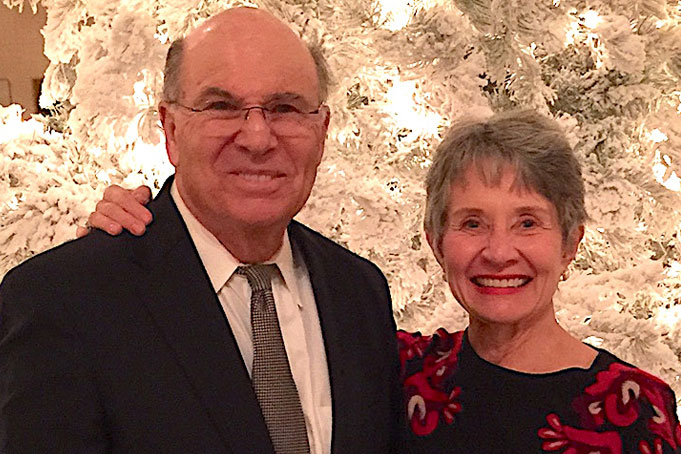
I have been incredibly blessed with my wife, Lynn, of over 50 years (who is much smarter than I am), two great daughters, Laura and Leslie, and three great-granddaughters, Keala, Kailani, and Mackenzie. Science has allowed us to travel around the world and meet all kinds of interesting people. We are big fans of the World Affairs Council and a variety of SMU activities. While I played a lot of tennis in the past, I have become a “golf addict” – and have met many interesting people while playing on public courses.
If you could solve one medical or scientific problem, what would it be?
My long-term goal is to be able to perform studies on an individual patient’s tumor and from that information select the best available treatment for that one patient by knowing all of the genetic changes that took place in the tumor. There will be at least 250,000 new cases of lung cancer diagnosed in 2019. If we knew the results in all those patients in terms of cures, survival, complications, quality of life, and costs, we would have a much better understanding of how well these various therapies are doing and whether we are making real progress.
Dr. Brown, a Regental Professor, is Director of the Erik Jonsson Center for Research in Molecular Genetics and Human Disease. He holds The W.A. (Monty) Moncrief Distinguished Chair in Cholesterol and Arteriosclerosis Research, and the Paul J. Thomas Chair in Medicine.
Dr. Goldstein, a Regental Professor, is Chair of Molecular Genetics. He holds the Julie and Louis A. Beecherl, Jr. Distinguished Chair in Biomedical Research, and the Paul J. Thomas Chair in Medicine.
Dr. Minna holds the Max L. Thomas Distinguished Chair in Molecular Pulmonary Oncology and the Sarah M. and Charles E. Seay Distinguished Chair in Cancer Research.

